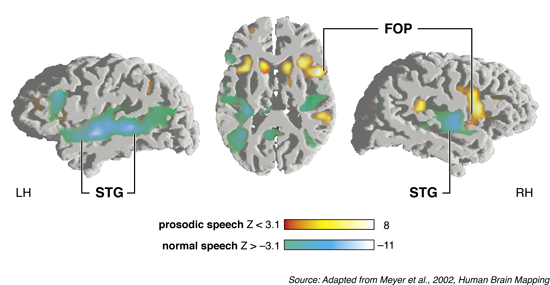Prosodic processes
- Spoken sentence, in addition to semantic and syntactic information, carry prosodic information. Two types of prosodic information can be distinguished: linguistic prosody and emotional prosody which is non-linguistic. Here only linguistic prosody will be considered.
- Linguistic prosody can have different functions: (1) it can signal whether an utterance is a declarative or a question by falling or raising the pitch contour, (2) it can have a thematic function as it can put something in focus (by intonation and stress), and (3) it can signal phrase boundaries (by varying three parameters varying the pitch contour, lengthening the pre-boundary syllable and putting a pause after the boundary).
- The following two examples show that the prosodic boundary is relevant for the syntactic structure of a sentence and thereby its meaning.
- “In the example, # indicates the prosodic boundary (PB).
- (a) The man said # the woman is stupid.(b) The man # said the woman # is stupid.
- The PBs in these sentences are crucial for the interpretation as they signal the noun phrase to which the attribute “to be stupid” has to be assigned – either to the woman (a) or to the man (b).”
- (see Physiological Reviews, Friederici, 2011, The Brain Basis of Language Processing: From Structure to Function.)
- Prosodic information at the phrase and sentence level is mainly processed in the right hemisphere (Meyer et al., 2002; 2004; Strelnikov et al., 2006). It has been shown, however, that the right hemispheric preponderance for prosodic processes at the sentential level is dependent on task demands (Gandour et al., 2004; Plante, Creusere & Sabin, 2002) and on the presence of concurrent segmental information (Bryan, 1989; Friederici & Alter, 2004).
- Prosodic information that encodes lexical meaning as in tonal languages, in contrast, is processed in the left hemisphere (Gandour et al., 2000).
- Figure 11 demonstrates the brain regions activated for normal speech and for prosodic speech, that is speech in which all segmental information is filtered out and only prosodic information remains. Brain activation in the right hemisphere is observed in the superior temporal and the inferior frontal cortex (Meyer et al., 2002).
- To summarize, prosody is localized in the RH, but primarily when it marks sentence level aspects.

Figure 11: Brain activation during prosodic processes
Activation for sentence level prosodic information. Activation for prosodic speech (no segmental information, only suprasegmental information) vs normal speech (segmental and suprasegmental information) is color coded in red-yellow, activation for normal speech vs prosodic speech is color coded in green-blue. Figure legend is taken Friederici, 2011 (Physiological Reviews, 91(4), 1357-1392).